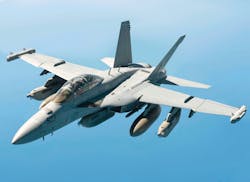Navy surveys industry for companies to upgrade and consolidate EA-18G electronic warfare (EW) transmitters
CRANE, Ind. – U.S. Navy airborne electronic warfare (EW) experts are surveying industry to find companies able to design and build a wideband EW transmitter for the EA-18G Growler aircraft that can jam enemy RF signals operating in bands from 20 MHz to 3 GHz.
Officials of the Naval Surface Warfare Center (NSWC) Crane Division in Crane, Ind., issued a request for solutions (N0016421SNB41) last week for the AN/ALQ-99 Tactical Jamming System (TJS) Low Band Consolidated (LBC) and improved Universal Exciter Upgrade (iUEU) prototype project.
NSWC Crane experts are searching for a company to design and build an EW transmitter with gallium nitride (GaN) technology, as well as an improved universal exciter upgrade (iUEU) that solves obsolescence problems with application-specific integrated circuit (ASIC) prototypes.
The ALQ-99 is an airborne integrated jamming system designed and manufactured by EDO Corp., which since has been consolidated into L3Harris Technologies. The ALQ-99 receiver and antennas are mounted in a fin-tip pod on the EA-18G, while jamming transmitters and exciter equipment are located in under-wing pods.
The system is designed to intercept, automatically process, and jam enemy RF signals from radio communications and radar. It also can detect, identify, and locate radio waves in a signals intelligence (SIGINT) mode.
The ALQ-99's low-band transmitter has replaced the ALQ-99's tactical jamming system in EW bands 1, 2, and 3, ranging from 20 MHz to 1 GHz. Navy experts want the system's transmitters with GaN technology to include band 4, which operates from 1 to 3 GHz, and to consolidate several transmitters into one transmitter.
The project also seeks to mitigate obsolescence within the ALQ-99's transmitters, and update the technology to use GaN materials for semiconductor power devices. The goal is not to increase the system's power output, but instead to address diminishing manufacturing sources, material shortages, and mitigate band 4 hardware inventory shortages.
Companies interested must be members of the Strategic & Spectrum Missions Advanced Resilient Trusted Systems (S2MARTS) consortium. Find out more about the organization and how to join it online at https://s2marts.org. More information about this project is on the organization's website at https://nstxl.org/opportunity/low-band-consolidated-lbc-and-improved-universal-exciter-upgrade-iueu-prototypes-conceptual-plans/.
Companies interested should submit solutions no later than 24 March 2021 online at https://nstxl.org/login/?redirect_to=https%3A%2F%2Fnstxl.org%2Fsubmit-aproposal%3Fopid%3D12217.
Email questions or concerns to the Navy's Jordan Black at [email protected], or Don Davis at [email protected].
More information is online at https://beta.sam.gov/opp/33af6b00fa594dcd808b4ac3dd764293/view.

John Keller | Editor-in-Chief
John Keller is the Editor-in-Chief, Military & Aerospace Electronics Magazine--provides extensive coverage and analysis of enabling electronics and optoelectronic technologies in military, space and commercial aviation applications. John has been a member of the Military & Aerospace Electronics staff since 1989 and chief editor since 1995.

